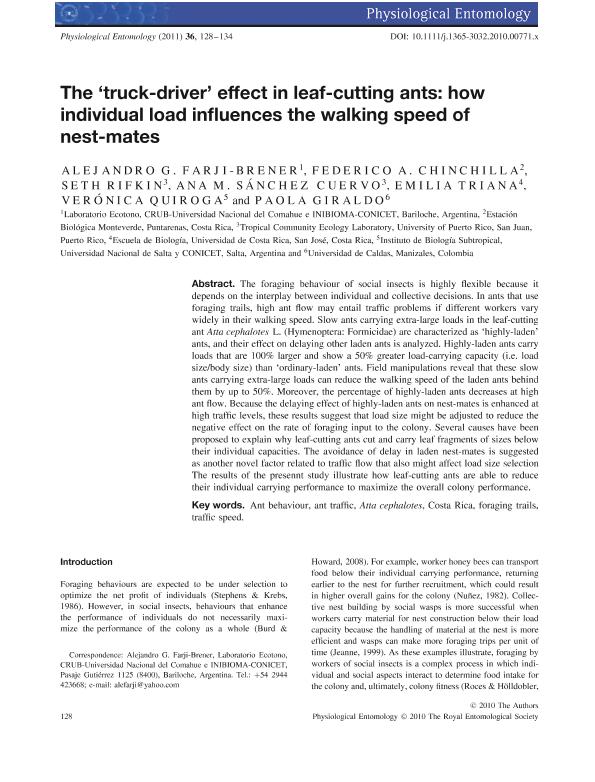Mostrar el registro sencillo del ítem
dc.contributor.author
Farji Brener, Alejandro Gustavo

dc.contributor.author
Chinchilla, Federico A.
dc.contributor.author
Seth, Rifkin
dc.contributor.author
Sanchez Cuervo, Ana Maria

dc.contributor.author
Triana, Emilia
dc.contributor.author
Quiroga, Verónica Andrea

dc.contributor.author
Giraldo, Paola
dc.date.available
2018-04-25T18:51:10Z
dc.date.issued
2011-06
dc.identifier.citation
Farji Brener, Alejandro Gustavo; Chinchilla, Federico A.; Seth, Rifkin; Sanchez Cuervo, Ana Maria; Triana, Emilia; et al.; The ‘truck-driver’ effect in leaf-cutting ants: how individual load influences the walking speed of nest-mates; Wiley Blackwell Publishing, Inc; Physiological Entomology (print); 36; 2; 6-2011; 128-134
dc.identifier.issn
0307-6962
dc.identifier.uri
http://hdl.handle.net/11336/43489
dc.description.abstract
The foraging behaviour of social insects is highly flexible because it depends on the interplay between individual and collective decisions. In ants that use foraging trails, high ant flow may entail traffic problems if different workers vary widely in their walking speed. Slow ants carrying extra‐large loads in the leaf‐cutting ant Atta cephalotes L. (Hymenoptera: Formicidae) are characterized as ‘highly‐laden’ ants, and their effect on delaying other laden ants is analyzed. Highly‐laden ants carry loads that are 100% larger and show a 50% greater load‐carrying capacity (i.e. load size/body size) than ‘ordinary‐laden’ ants. Field manipulations reveal that these slow ants carrying extra‐large loads can reduce the walking speed of the laden ants behind them by up to 50%. Moreover, the percentage of highly‐laden ants decreases at high ant flow. Because the delaying effect of highly‐laden ants on nest‐mates is enhanced at high traffic levels, these results suggest that load size might be adjusted to reduce the negative effect on the rate of foraging input to the colony. Several causes have been proposed to explain why leaf‐cutting ants cut and carry leaf fragments of sizes below their individual capacities. The avoidance of delay in laden nest‐mates is suggested as another novel factor related to traffic flow that also might affect load size selection The results of the presennt study illustrate how leaf‐cutting ants are able to reduce their individual carrying performance to maximize the overall colony performance.
dc.format
application/pdf
dc.language.iso
eng
dc.publisher
Wiley Blackwell Publishing, Inc

dc.rights
info:eu-repo/semantics/openAccess
dc.rights.uri
https://creativecommons.org/licenses/by-nc-sa/2.5/ar/
dc.subject
Hormigas
dc.subject
Comportamiento
dc.subject
Traileras
dc.subject
Atta
dc.subject
Ant Behaviour
dc.subject
Ant Traffic
dc.subject
Foraging Trails
dc.subject
Traffic Speed
dc.subject
Costa Rica
dc.subject.classification
Otras Ciencias Biológicas

dc.subject.classification
Ciencias Biológicas

dc.subject.classification
CIENCIAS NATURALES Y EXACTAS

dc.title
The ‘truck-driver’ effect in leaf-cutting ants: how individual load influences the walking speed of nest-mates
dc.type
info:eu-repo/semantics/article
dc.type
info:ar-repo/semantics/artículo
dc.type
info:eu-repo/semantics/publishedVersion
dc.date.updated
2018-04-18T15:17:13Z
dc.journal.volume
36
dc.journal.number
2
dc.journal.pagination
128-134
dc.journal.pais
Reino Unido

dc.journal.ciudad
Londres
dc.description.fil
Fil: Farji Brener, Alejandro Gustavo. Consejo Nacional de Investigaciones Científicas y Técnicas. Centro Científico Tecnológico Conicet - Patagonia Norte. Instituto de Investigaciones en Biodiversidad y Medioambiente. Universidad Nacional del Comahue. Centro Regional Universidad Bariloche. Instituto de Investigaciones en Biodiversidad y Medioambiente; Argentina. Universidad Nacional del Comahue. Centro Regional Universitario Bariloche. Laboratorio de Ecotono; Argentina
dc.description.fil
Fil: Chinchilla, Federico A.. Universidad de Costa Rica. Estación Biológica Palo Verde; Costa Rica
dc.description.fil
Fil: Seth, Rifkin. Universidad de Puerto Rico; Puerto Rico
dc.description.fil
Fil: Sanchez Cuervo, Ana Maria. Universidad de Puerto Rico; Puerto Rico
dc.description.fil
Fil: Triana, Emilia. Universidad de Costa Rica. Escuela de Biología; Costa Rica
dc.description.fil
Fil: Quiroga, Verónica Andrea. Universidad Nacional de Salta; Argentina. Consejo Nacional de Investigaciones Científicas y Técnicas. Centro Científico Tecnológico Conicet - Nordeste. Instituto de Biología Subtropical. Universidad Nacional de Misiones. Instituto de Biología Subtropical; Argentina
dc.description.fil
Fil: Giraldo, Paola. Universidad Nacional de Caldas; Colombia
dc.journal.title
Physiological Entomology (print)

dc.relation.alternativeid
info:eu-repo/semantics/altIdentifier/url/https://onlinelibrary.wiley.com/doi/abs/10.1111/j.1365-3032.2010.00771.x
dc.relation.alternativeid
info:eu-repo/semantics/altIdentifier/doi/https://doi.org/10.1111/j.1365-3032.2010.00771.x
Archivos asociados
